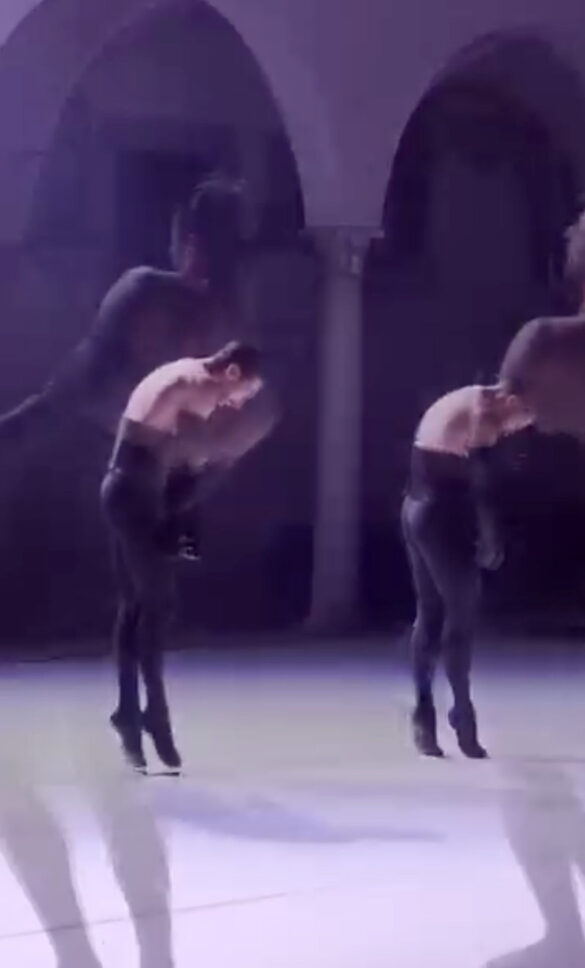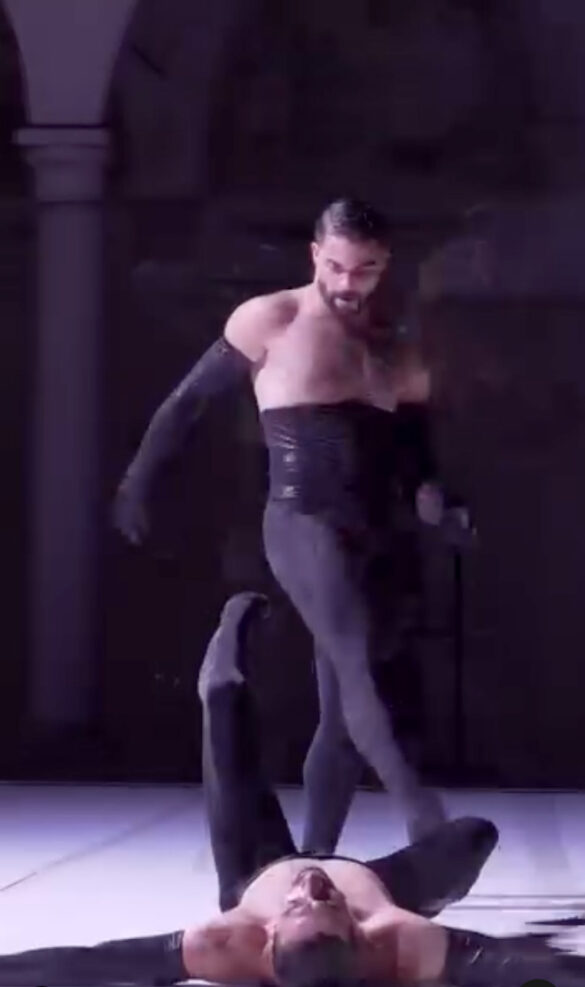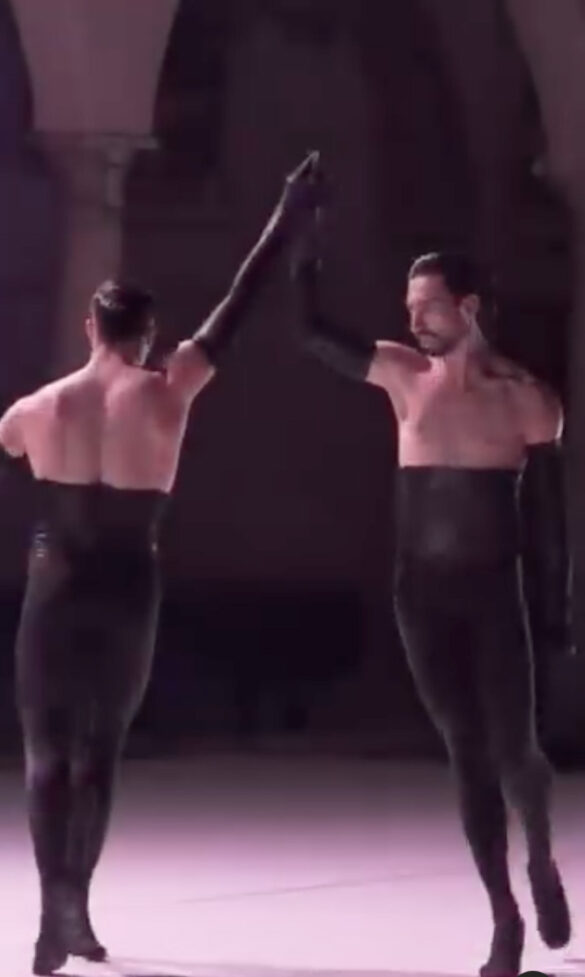Almost exactly a year after seeing ISHIDA’s Keepsake at the Hobby Center’s Zilkha Hall in downtown Houston, I went back there to watch the Japanese-American choreographer’s new concert as long as there is in me, featuring four new pieces, two created by guest choreographers, and two more by Brett Ishida herself after intermission. As is her custom, the company director stepped out in front of the red curtain to tell the audience both nights were sold out: a testimony to the rising success of this organization, with its formidable outreach to the community (and beyond) and to supporters who help to finance her dance work. She briefly emphasized her method to pick up, for each new project, some talented, highly trained dancers, to bring them to Texas audiences, this time from Europe and North America, as well as commission new choreography from guest artists like Drew Jacoby, who currently resides in Barcelona, and Mauro Astolfi, director of Spellbound Contemporary Ballet in Rome.
The Europe-based choreographers start off strong, with Jacoby’s Waltz featuring a stark, ominous scenario of two men, distanced from one another at first, walking strange geometric lines with jerky robotic movement around the perimeter (reminiscent of Samuel Beckett’s Quad, his television play for several “figures, light and percussion”). They are dressed in astonishing costumes with long black gloves, cut off at the chest to leave their upper bodies bare. Set to intimidating music by Les Stuck, the duet – featuring tall Daniel Domenech and smaller Thomas Martino – begins in the near dark and ends in the near dark. The lighting by Jacoby and Hudson Davis just allows us to barely see the dancer’s exquisite, athletic, and virtuosic technical prowess — their strength and daring. They begin to circle each other, sometimes quickly tiptoeing en pointe, with large arm gestures flying across their torsos, occasionally hands becoming bird-like beaks. I also think of extravagant penguins, tarred in black as if after an oil spill on some distant shore, running off into the wild like in Werner Herzog’s movie Encounters at the End of the World, where the director’s narrative mentions one disoriented, insane penguin leaving his colony to climb up a mountain, just like Fitzcarraldo.
I still see the two masculinities strutting and fretting in front of me in my dreams, the Fitzcarraldos who end up in an erotic embrace — not really a waltz, but some contorted tight-wrapped, staggering movement that fulfills their hovering presence. They have a quietly orgasmic union. Jacoby’s choreography is challenging, her balletic vocabulary quite visibly distorted and quirky, to the point where you see her work struggling to know what it is conveying: is it parody, humor, or a form of camp that tries to please us, the many gay couples in the audience who lavish their affection on the beautiful dancers who deserve the affection, but in some sense also leave us questioning the sheer display of physical virtuosity. What exactly is their relationship, I kept wondering, without figuring it out. What is this “waltz” telling me about attraction and repulsion, or about disorientation that might drive me to walk into the fire or the ice?



This sense of ambivalence runs through the entire evening. The lighting is exhaustively dim, not letting me see much of the dancers’ individual expressions or personalities in Astolfi’s It’s Happening Now, or feel their breath in a gesture. The dynamics of a human gesture are vital: let me see and hear it. The dense music collage that opens with mysterious whisperings, clatterings of urban noise (with sonic experimentation by Norn, Roly Porter, Christian Löffler, a short “Epilogue” by Jed Kurzel fused with “Thoughts that do often lie too deep for tears” by nouseskou) is often too loud and continuous, not allowing a moment of silence, taking a breath. One gets the impression Astolfi uses the soundtracks as film music to cinematic sequences, quickly cut and edited, with occasional freeze frames to heighten the tension provoked by speed.
The stage has props: a table with chairs for a family of six, seated quietly at the beginning, upstage right, before the movement starts in spurts of high-energy flurries, very quickly, pulsating gestures and highly acrobatic movement throughout, though there are changes in emphasis. Sometimes one dancer sits on a chair, now pushed downstage, watching a duet or a trio as a spectator. The young, exuberant Sam Fine engages a chair in a duet downstage that is perhaps more emotionally and sensually riveting than all the other dancers’ fast, slick, and dexterous dancing. However, Mariangela Ferraioli, Chiara Pignataro, Sofia Fagioli, John Canfield, and Sam Fine (the female dancers are from Astolfi’s Spellbound Contemporary Ballet company) seem bound to try their best to impress us with their immaculate technical virtuosity.
Regarding the stage design, the presence of the table is visible, and although the prop is moved on occasion (tilted, turned), the physical impact is minimal as the dancers never really engage with it in the same organic and expressive manner in which Fine explores his loving duet with the chair. It remains an empty symbol (even if Norn’s music track, “Balor,” oddly enough, is produced by Moving Furniture Records) without impact on the choreography, which pursues its furious, fast motions and intensity largely for a tonality, a speed-vocabulary, that soon becomes stuck in its pain-tension effect – an effect that grows monotonous. The movement increasingly becomes predictable, remaining on the same frequency.
In the second half of the concert, Ishida’s not your swan lake, danced by Sofia Fagioli and Sam Fine and set to Tchaikovsky’s Swan Lake Suite (scene IV), opens another quirky and irreverent view of classical ballet, this time focusing on a duet that shows equal prowess by female and male partners, in fact making us see Sam Fine as an eloquent persuasive force provoking different reactions from the “swan queen” in the grand pas de deux. They both wear glittering trousers, and it is delightful to see their coming together and staying apart: a modern couple bathed in old 19th-century romantic music (no black swan here), poking fun at each other, at times, with tiny little gestures. This is a successful small investigation, one might say, of the power relations in classical ballet, even as there is no real deconstruction of the role of the prima ballerina, or the male danseur.

“soul-writer,” choreographed by ISHIDA, with Juliet Doherty, Amelia Shultz, Chiara Pignataro, Thomas Martino, Daniel Domenech, and Heriberto Menses Matachana, 2025. Photo: Amitava Sarkar
In the final dance, soul-writer, Ishida goes all-in, as they say in sports, however, her narrative of a spiritist séance (late19th century?), set on stage around a brown oak table with 6 chairs, backfires considerably, as the soul-writing makes us cringe. The pretension of calling back a deceased loved one, a Mother, here meant to meet her sisters, husband, and sons, never comes off as a believable theatrical illusion, nor as a suitable vehicle for contemporary art. The brothers, initially introduced as mourning men wearing black tails, jostle around when a ghost makes its entrance through the house, laying her onto the table to lie still as the departed Mother, then escort the rest of the family onstage to place them around the table. Hands are held. The brothers become MCs who monitor the action. More laying on of hands; later the sisters frolic around in their lavish, frilly dresses.
The action, however, consists of a sequence of meaningless ballet extensions, high legs and pirouettes, lifts on the table, whirling long hair, swooning and fainting, playful bantering between the “sisters,” a passionate “Mother” duet with the ”Husband,” and then the death, and the non-existing (rest is) silence. The loud music keeps pounding on. There never is any sensitivity (in the dramaturgical conceptions of the dances) towards the need for counterpoint, or relief, for a pause from continuing intensity, for a bit of subtlety. If
European choreographers are invited, why not proponents of tanztheater? Artists who encourage dancers to reveal their individuality and personality? To work against the grain? The works on this program are always worth watching regarding the flashy surfaces of the dances, but they are conceptually and intellectually weak. The dancers are not allowed to breathe and express themselves, through the smoke screen.
In soul-writer, the passing of the Mother, or why the family wants to raise her spirit, is never realized in a narrative and theatrical way that makes sense; thus the dancing increasingly grows embarrassing, a futile effort to translate any emotional or intellectual-aesthetic substance. Mourning, in an artistic spectacle that aims at impressing us with beauty and a retrograde spiritist fantasy, will not become real. It will not persuade but remain shallow surface. In my view, the most serious mistake made by the choreographer is her coming out, before the dance, standing in front of the curtain to tell us the meaning of her script, and her narrative plan, exhorting us to remember our lost ones whom we might want to spirit back. Such telling is manipulative at worst, and naïve at best, since it tries to prepare the audience for a spectacle, in this case performed by a highly professional and talented dance group, which is driven by narrative force. In the end, we do not see any force or any contemporary dance. We see gesturings at a vain poetic surface beauty, offering us spectacle with attractive dancers who are stuck in a discomforting frame where they can only fail. The audience cheered at the end, offering applause, probably fully aware that they just witnessed a misstep, but nevertheless appreciating ISHIDA’s daring to present fresh work and bring in an international cast of movement artists who are surely worth watching. A little less special-effect fog from the old theatre smoke machine (second half of the concert) might be helpful. I also hope the company will have a lighting designer next year who will allow us to see the individual dancers a bit better.
ISHIDA as long as there is in me Hobby Center for the Performing Arts, Houston, January 10-11, 2025 and The Rollins Theatre at the Long Center for the Performing Arts, Austin, January 13-14
Johannes Birringer is a choreographer and media artist. He co-directs the London-based DAP-Lab and has created numerous dance-theatre works, video installations, and digital projects in the Americas, Europe, and Asia. The telematic dance The river of no one premiered in 2022; he directed the play The Price of Water in London in 2023. His latest book is titled Kinetic Atmospheres (Routledge, 2021).



